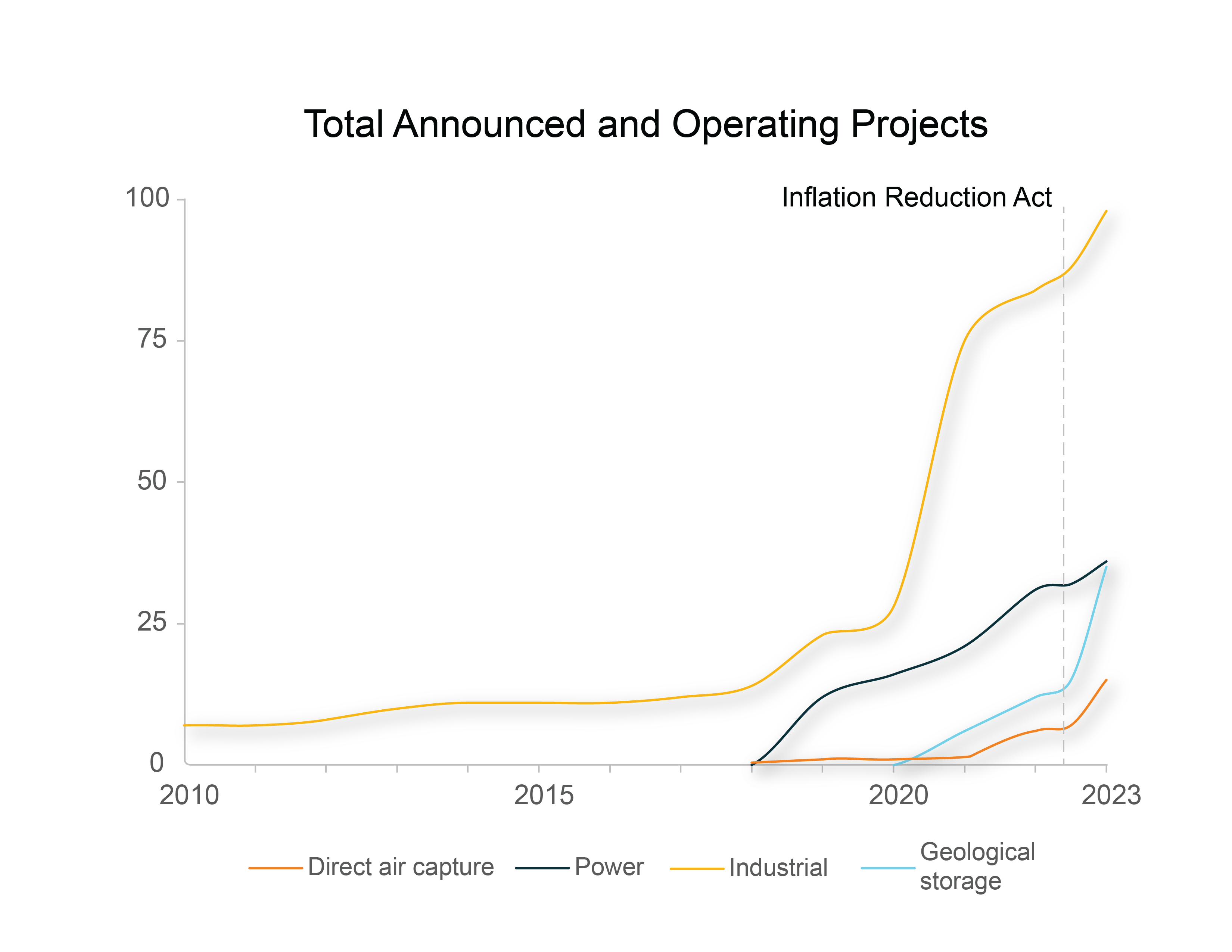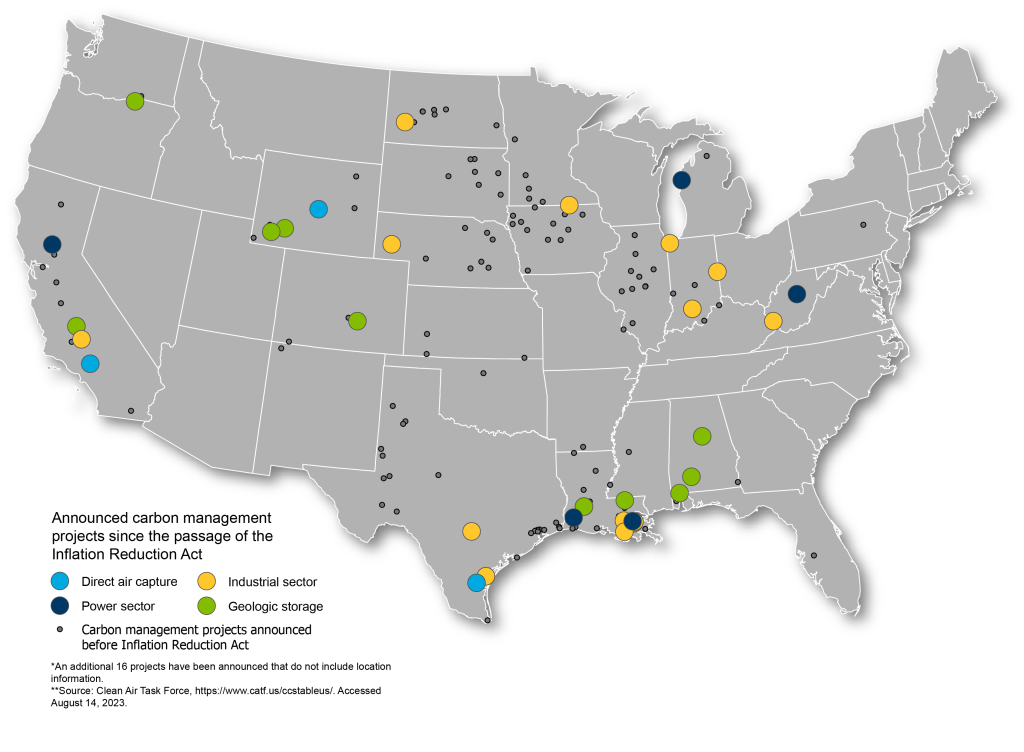Coalition Marks One-Year Anniversary of Inflation Reduction Act and its Historic Carbon Management Provisions
August 15, 2023 | Blog
The Inflation Reduction Act (IRA) was signed into law by President Biden on August 16, 2022, and tomorrow marks one year since the enactment of the most consequential investment in climate and energy policy in our nation’s history. The law included groundbreaking, widely-supported, bipartisan provisions needed to deploy carbon management technologies economywide, prioritize industrial decarbonization and scale associated clean energy infrastructure at the pace required to meet midcentury climate goals, foster domestic energy and industrial production, and provide environmental and economic benefits to affected communities. Coupled with the historic investments made in the Bipartisan Infrastructure Law, this package provided the most transformative and far-reaching policy support in the world for the economywide deployment of carbon management technologies, making a critical down payment on the investments in American innovation required to achieve net-zero emissions.
Reflecting on the one-year anniversary of IRA’s enactment, the Carbon Capture Coalition is taking stock of the implementation of this historic law and specifically, the unprecedented federal policy support for deploying carbon management technologies at commercial scale. The Inflation Reduction Act reinforced the essential role these technologies will play in our nation’s broader climate strategy and solidified America’s domestic energy, industrial and manufacturing sectors as leading the way to a decarbonized global economy by providing monumental enhancements to this suite of technologies foundational policy, the federal Section 45Q tax credit. Though the Inflation Reduction Act was passed through the budget reconciliation process, the landmark law contained broadly supported carbon management priorities drawn from bipartisan legislation introduced in the 117th Congress, including:
- Direct Pay
- For profit entities: Under the Inflation Reduction Act, project developers will, for the first time, have the option to access direct pay for the full value of the tax credit, for the first five years after the carbon capture equipment has been placed in service. The remaining seven years of the credit must be financed through alternative means.
- Tax-exempt entities: These enhancements are even more expansive for tax-exempt organizations, i.e. nonprofit projects, cooperatives, and municipal utilities, which have the option to access direct pay for the entire lifetime of the credit (12 years);
- Multiyear Extension of the Commence Construction Window: The commence construction deadline for carbon capture, direct air capture or carbon utilization projects will extend seven years to December 31, 2033;
- Increased Credit Values for Industry and Power Projects: The value of 45Q will increase to $85 per ton for storage in secure geologic formations from industrial and power generation carbon capture and $60 per ton for either carbon utilization or permanent storage in oil and gas fields;
- Increased Credit Values for Direct Air Capture Projects: The credit value will increase to $180 per ton for storage in secure geologic formations from direct air capture and $130 per ton for carbon utilization or secure storage in oil and gas fields;
- Dramatically Reduced Annual Capture Thresholds: The annual capture threshold for credit-eligible carbon capture facilities will decrease dramatically, leading to a significant increase in 45Q-eligible projects.
Implementation of these essential enhancements is fully underway at the Internal Revenue Service (IRS) and the U.S. Department of the Treasury (Treasury). In preparation for the issuance of additional guidance and regulations on large swaths of the tax code, IRS has sought comment from external stakeholders on suggested recommendations and requested clarifications on policies contained within the law. For several months, members of the Carbon Capture Coalition have engaged in a collaborative effort to develop consensus recommendations to inform and assist Treasury and the IRS in the development of regulations and guidance to implement the expansion of the section 45Q tax credits that will encourage the deployment of a broad array of carbon management projects. You can read the Coalition’s comments on direct pay and transferability here and 45Q-specific provisions here. As IRS continues the rulemaking process for 45Q and other tax credits restructured or created under the Inflation Reduction Act, the Coalition will continue to monitor implementation of the law to ensure that it is consistent with congressional intent.

While we await final guidance from IRS and the Treasury, what is clear is that these enhancements to the foundational Section 45Q tax credit are already paying dividends. In the year since the enactment of IRA, more than fifty carbon capture projects have been announced nationwide. This wave of new project announcements signals that increased federal policy support for carbon management technologies will indeed translate into real-world projects. These monumental improvements to 45Q are expected to drive additional project developments in the industry, power and direct air capture sectors – emissions sources where deployment of carbon management technologies is essential if we are to meet the administration’s goal of a 50 percent emissions reduction by 2030 and midcentury climate obligations. Bottom line: these incentives are already showing to be critical to the continued growth and development of the carbon management industry and their enactment into law is yet another indication of the vital role they will play in climate and energy policy in the decades ahead.

With the necessary supportive policy levers now in place through both the IRA and BIL, a-once-in-a-generation opportunity has been presented to scale the carbon management sector, and the industry must now work to deploy these technologies as quickly and responsibly as possible. Additionally, while the efforts to strengthen 45Q under the 117th Congress were transformative, further small-scale adjustments to the tax credit will be necessary to ensure investment certainty and business model flexibility.
In its 2023 Federal Policy Blueprint, the Coalition provided a roadmap of targeted, pragmatic recommendations for consideration by the 118th Congress to underpin and grow the role of American leadership in the development and deployment of carbon management technologies throughout the remainder of this decade and beyond, including:
- Creating parity between carbon utilization credit levels and those associated with geologic storage: While the IRA increased 45Q credit values across the board, the credit is bifurcated between permanent storage of captured CO2 and the utilization of CO2 for reuse to produce commercially valuable products, or to produce additional oil from depleted oil and gas wells. However, reusing carbon to produce products is not yet cost competitive with incumbent technologies. Making the credit values for carbon reuse consistent with those provided for the geologic storage of CO2 is a necessary and important step to providing commercial certainty to this nascent but growing sector and to support full decarbonization of the economy.
- In February 2023, legislation introduced by Sens. Sheldon Whitehouse (D-RI) and Bill Cassidy (R-LA) along with Representatives David Schweikert (R-AZ-1) and Terri Sewell (D-AL-7), and subsequently endorsed by the Coalition, aimed to close the cost gap for projects recycling captured carbon into low- and zero-carbon products, by providing increased credit values for carbon utilization projects.
- Index 45Q for inflation: Unlike other low- and zero-emissions technology tax credits recently reformed or created under IRA, the 45Q tax credit value is not adjusted for inflation until 2026. Already, much of the increased credit value realized in recent 45Q enhancements has been eroded due to significant inflation in both capital goods costs and energy price increases. To prevent further reduction of the credit value in today’s dollars, 45Q should be adjusted for inflation much sooner than current statute allows.
The historic investments made in carbon management policy under the IRA marked an essential step forward in fostering the economywide deployment of carbon management technologies to achieve midcentury emissions reduction targets, while safeguarding high-wage jobs that sustain families and communities and ensuring the long-term viability of key domestic industries. In tandem with the historic investments made in the Bipartisan Infrastructure Law, if properly implemented, the portfolio of complementary policies included in this package will deliver an estimated 13-fold scale-up of carbon management capacity and 210-250 million metric tons in annual emissions reductions by 2035. As we look toward the full implementation of these important enhancements, the Coalition remains committed to working closely with our federal and external partners to ensure that these groundbreaking policies work as efficiently and effectively as intended, while advocating for the next generation of carbon management policies needed to meet greenhouse gas emissions reduction targets.
###
Convened by the Great Plains Institute, the Carbon Capture Coalition is a nonpartisan collaboration of more than 100 companies, unions, conservation and environmental policy organizations, building federal policy support to enable economywide, commercial scale deployment of carbon management technologies. This includes carbon capture, removal, transport, utilization, and storage from industrial facilities, power plants, and ambient air.
